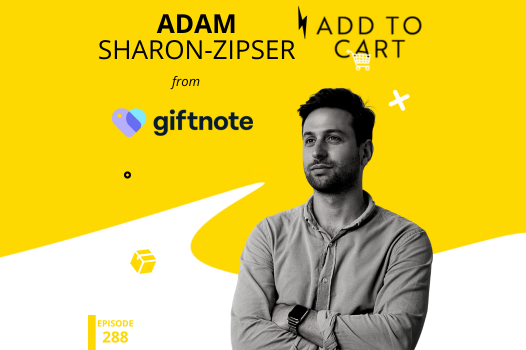In this episode of Add To Cart, we are joined by Adam Sharon-Zipser, founder of Giftnote
Giftnote is a Shopify app which allows gift givers to have an SMS or email arrive to the gift recipient within 30 minutes of their delivery. This solves the problem of impersonal, or even worse, unknown deliveries. Adam is also the founder of Elephant Room, an ecommerce agency that helps ecommerce brands grow through paid performance, website development, UX, integrations, analytics and a lot more. They have worked with brands including Boody, Bed Threads and Sit the Label. I wanted to have a chat with Adam to dive into the gift giving experience from a solutions perspective. We’ve had lots of gifting brands join us on the show, but I wanted to hear from someone who is breaking down the gifting barriers for all. I am very bullish on the opportunity to radically improve the online gifting experience. In this chat we cover how Giftnote is improving the gifting experience and talk to what a great gifting experience looks like. We also go broader than gifting and cover how to outsmart the performance media algorithms (hot tip – you can’t) and Adam’s favourite measurement tools for different sized ecommerce businesses.

“AOV is 20% greater for gifts compared to your baseline.”
Adam Sharon-Zipser
Gift confusion
“COVID came around and my dad had his 70th. We ended up sending my dad, between my both my brothers and the whole family, a wardrobe. It was an RM Williams wardrobe, we spent quite a bit of money, it was quite nice. He sent on the WhatsApp, thanks for the gift, but I don’t know who sent it, which son sent it? And then I messaged my brothers on a private WhatsApp, I’m like, what the fuck? We spent so much money. How did he not know who it was from? Was there no card, no message?
And we had actually implemented a similar bit of tech for another client. And with some smarts of the tech, we went down this path of, how do we solve this problem? Surely we can solve this problem?”
18-70% reconversion rate
“So AOV is 20% greater for gifts compared to your baseline. So that’s pretty cool. AOV is one of the golden metrics with sessions and conversion rate that all merchants want to lift accurately, the incremental sort of downward impact is huge. So that was that.
But the other one was the first time customer conversion rate from recipients. So if I buy you the socks for your birthday, and then you love them so much, you buy another pair of socks because you’re gifted the socks, because we’ve identified you as a recipient, we’re watching every new order come in, and then you reconvert as a first time customer that we sent to you say, hey, Nathan, happy birthday. And here, by the way, he’s 10% of your first purchase, we actually can see some pretty cool stuff. There’s like an 18% reconversion rate from recipients to first time customers. And some brands are very different. Some brands it’s 70% if they’re pure gifting brands.”
Incrementality testing
“It depends on the brand. If they’re spending over 250,000 a month, there’s a whole suite of media-mix modelling tools and it’s a massive statistical framework. My concern and what we’re nervous about is that a lot of marketers who are incredibly savvy and switched on, not too many agencies have data science degrees and they’re pretending to be practitioners in this space. Split testing is ubiquitous now. I think what’s significant between two variants or three variants, I think that’s an easier thing to dictate if you don’t have that background.
But looking at proper media mix modelling, causal impact, looking at the open source frameworks from Google and Meta, it’s very complicated. And that’s a bit of a black box right now. Recast is an amazing emerging company. There’s Biomodel in Australia.
But then if you’re under that spend, which 90 percent of the retailers are. We’ve been looking at incrementality testing. So, changing one thing and understanding the impact off everything else based on your notes, your branded impressions, your traffic and your revenue, and then looking at more aggregate numbers like an M E R and pacing your M E R over time. That’s the modern way to do marketing right now.”
Links from the episode
This episode was brought to you by…





